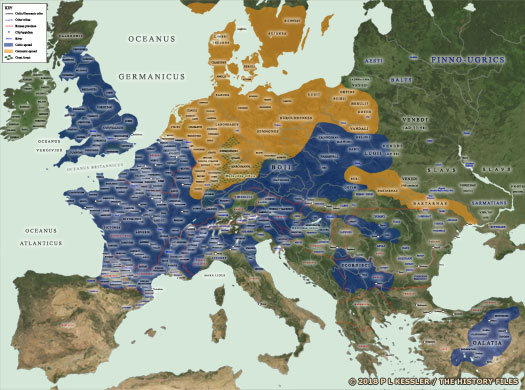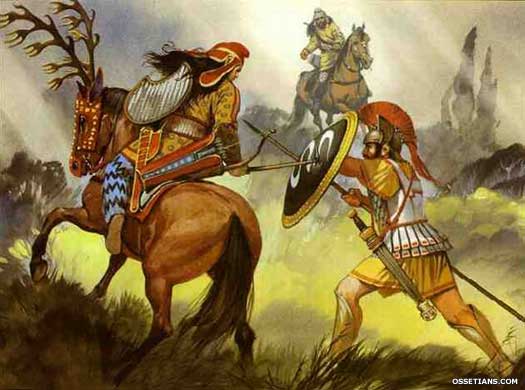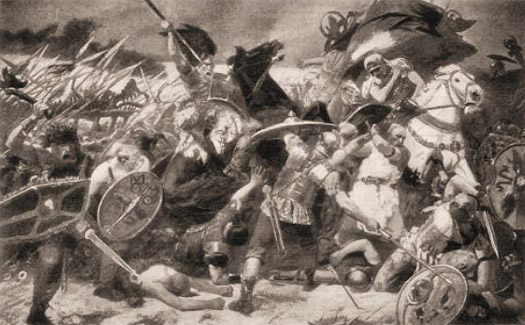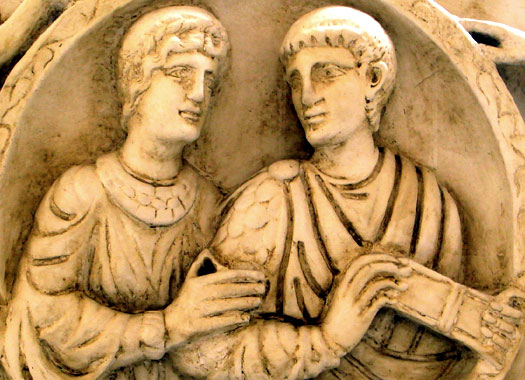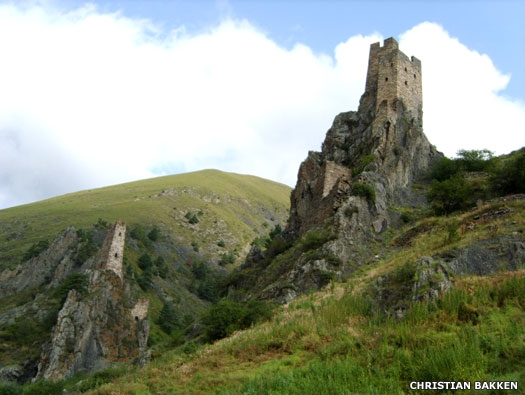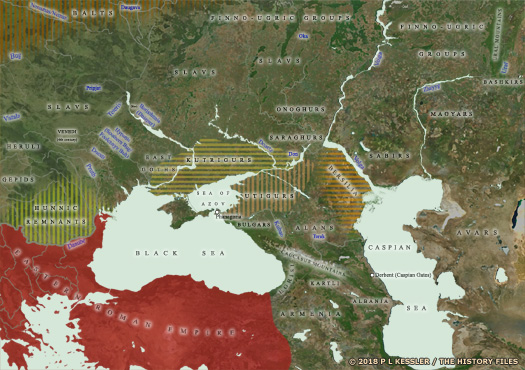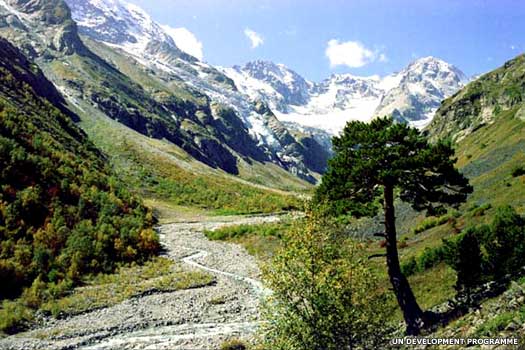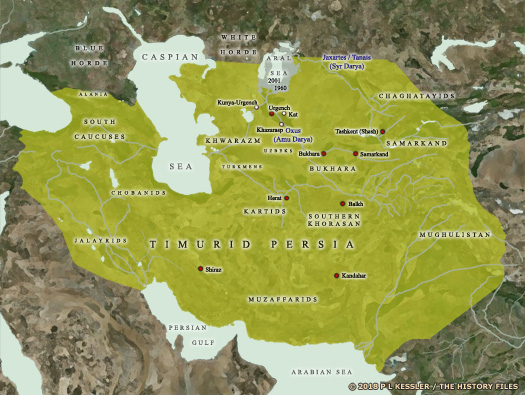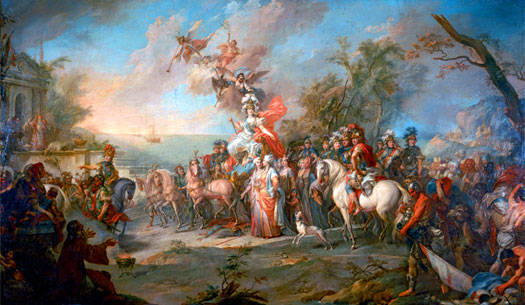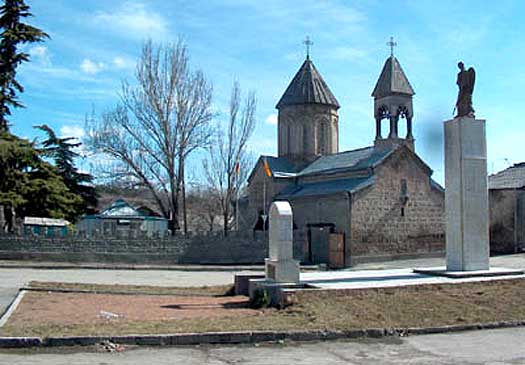
| ALANI Alans
(Alani / Geloni) :
The Alani were an Indo-European people of Indo-Iranian stock, just like their regional neighbours, the Mannaeans, Medians, Persians, Scythians, and others. Unlike those neighbours, the Alani retained a core of their people in the same general location - the northern Caucuses - for the greater part of their extremely complicated history and into the modern day. Other groups of Alani ventured out along the familiar paths of Indo-European migration, reaching central Europe in an initial phase so that they were present in Dacia, on the northern bank of the Danube, in the first centuries BC and AD. Initially the 'remainers' of the northern Caucuses were dominated by the Scythians.
The name 'Alan' or 'Alani' is an altered form of the Indo-European 'Arya', meaning the 'civilised' or 'respectable. Their East Indo-European cousins were documented as calling themselves Aryans when they entered India from around 1500 BC (although the tainted 'Aryan' term has been replaced by modern scholars with the more accurate 'Indo-Aryan'). This rather elitist naming was presumably in reaction to the apparently barbarous people they encountered (although this adoption occurred well before any of them entered India). Because the name would have been highly popular with Indo-Aryan groups, though, there is no guarantee that various mentions of Alani or variations of the name in different locations actually link back to those Alani who settled in the northern Caucuses. Popular names tend to get used by all sorts of people within the same general cultural group, even today.
In the case of these particular Alani, there is evidence of heavy contact between them and non-Indo-European languages, particularly from other nomads. The Alani appear to have been influenced by the proto-Bulgars and the many nomad groups which were part of their creation during the fourth to seventh centuries AD. For instance, the ruler of the Alani bore the proto-Bulgarian title of 'khan'. DNA analysis of modern Ossetians has also confirmed that North Ossetians have a heritage which includes external incomers (mostly males), while South Ossetians experienced a far greater connection with incoming males from the southern Caucuses. Unusually for incoming males, it was they who ended up speaking the Indo-Iranian language of their wives rather than imposing their own alien languages.
The Alani are first mentioned in the west in the first century AD by two Roman historians, Josephus and Strabo. Josephus refers to them as a Scythian tribe living near the Don (Tanais) and the Sea of Azov. They seem to be indivisible from the Samartians and the Geloni of the same region. Strabo refers to them as the As or Asioi (this name, As or Os, is itself a contraction of Asura which could be used by any number of Indo-Iranian groups, such as those in what is now Kazakhstan right up to the seventh century AD (the Az) - see feature link, right, for more information on As and Os). Five hundred-or-so years beforehand, Herodotus mentioned the Geloni (Gilans) - either a closely related group or, far more likely, the same group of people. The fourth century Roman writer Ammianus Marcellinus considered them to be the direct descendants of the Massagetae, while many others linked them to the Sarmatians, sometimes it seems as a form of elite unit. The Yancai of the first century BC were located farther to the east, suggesting a migration into the Caucuses between then and the fourth century, perhaps thanks to the Huns - and such a starting location would certainly allow them to be linked to the Massagetae. There were also (probable) elements of the Alani in the form of the Alauni and Roxolani along the Danube - on its northern bank - in the first century BC, showing how far their various (possible) divisions had migrated. Another name is used by sixth century Byzantine historian, Jordanes. He refers to the Spali being defeated by the Goths in the region to the south of Kiev in modern Ukraine as the latter migrated into the Pontic steppe in the second and third centuries AD. These have been linked to the Roxolani and also the Sarmatians, but it is entirely possible that all three groups are indivisible in this respect. The name Spali (shown as Spalaei or Palaei in Latin texts) shows a connection to Indo-Iranian royal names such as Spalirises of the Sakas (around 60 BC).
Attacked and conquered by the Huns, the main group of Alani in Scythia became allies (willingly or otherwise), and a large number travelled west with the Huns. Split by the attacks, some Alani tribes remained behind, dispersed across the steppe. They were forced by further waves of invaders - early Turkic groups (see map link, right, for more details) - to re-concentrate in the Caucuses where they eventually founded the regionally-powerful kingdom of Alania, only to be conquered by the Mongols in the thirteenth century. They re-emerged as the Ossetians, based in modern Georgia and southern Russia.
Culturally, it appears that the Alani were supporters of the widespread Indo-European practise of Rte. The fact that it has survived into modern times among their Ossetian descendants as a religion confirms this. Rte (the Sanskrit form of the name as used by Indo-Aryans) was a practical philosophy for daily life and spiritual life whose followers were devoted to the truth as 'what is'. This philosophy would have given its devotees a powerful advantage over their neighbours because they would have made practical, hard-nosed decisions rather than decisions based on fantasy or belief .
Uatsdin, a modern movement which in essence follows the same truth of 'what is', comes from the practice of Rte amongst Ossetians. In the exymology of the word, its last part - '-din' - is cognate with the Avestan 'daena', meaning 'insight, revelation'. The first element is trickier though, and some examinations fail to delve deep enough into it. The modern Ossetian organisation of Rte is known as Atsætæ. The meaning given for its basis, 'Ætsæg', is 'right, true', but in fact this consists of a base element and a suffix together. The base is 'Æts-' which appears to be a flipped vowel version of the verb 'to be', of the 'ist' and 'est' variety rather than the Arte and Rte. The suffix '-æg' is the familiar 'like unto' or 'similar to' or 'in the manner of' suffix that is used in modern English in the form of '-ish' and '-ic' (such as in 'English' and 'Scandic').
(Information by Peter Kessler, with additional information by Edward Dawson, from The Oxford History of England: Roman Britain, Peter Salway, from The Horse, the Wheel, and Language: How Bronze-Age Riders from the Eurasian Steppes Shaped the Modern World, David W Anthony, from Res Gestae, Ammianus Marcellinus, from Les Alains, Cavaliers des steppes, seigneurs du Caucase Ie-XVe siècle, Vladimir Kouznetsov & Iaroslav Lebedynsky (Editions Errance, Paris 2005), from Etnicheskaja istorija Severnogo Kavkaza, A V Gadlo, from Eucharisticos (Thanksgiving), Paulinus of Pella, from the Life of St Germanus of Auxerre, Constantius of Lyon, and from External Links: Indo-European Chronology - Countries and Peoples, and Indo-European Etymological Dictionary, J Pokorny, and Proto-Bulgarian Runic Inscriptions, and Geography, Strabo (H C Hamilton & W Falconer, London, 1903, Perseus Online Edition), and Genetic clues to the Ossetian past, Asya Pereltsvaig (Languages of the World), and The Alans, and Turkic History.)
c.100 BC :
Tasius : King of the Roxolani.
c.100 BC :
The Scythian ruler, Palacus, continues his father's war against Mithradates the Great of Pontus. An attempted siege of Chersonesos (Crimea) is defeated by Pontic troops, so Palacus enlists the Roxolani under Tasius and launches an invasion of Chersonesus. This too is defeated and the Scythians are forced to accept Mithradates as their overlord. The former capital of their kingdom now becomes the capital of the Cimmerian Bosporus kingdom.
The Alani formed part of a major incursion into Roman territory in the fifth century AD, but there had already existed sizable pockets of them (or their namesakes) in southern-central Europe in the first century BC, in the form of the Alauni and Roxolani, while above is a map showing the locations of European tribes around the first centuries BC and AD 90s BC :
The nomadic Yancai - later referred to as Alan-na - are recorded by Sima Qian of China, centred on the northern shore of the Aral Sea. Their territory lays to the north-west of the Kangju nomadic federation, with whom they hold some similarities in terms of customs. They may be a wandering group of Alani, but they may equally be a group that has adopted a variation of the same name - a form of the Indo-Iranian 'Arya', meaning the 'civilised' or 'respectable'. However, Arabic records of the Alani from around AD 1000 (see Alania, below) would seem to support a connection between these Yancai and the Alani.
Around the same time, two tribes on the banks of the Danube in southern-central Europe are generally linked to the Alani as sub-divisions of the main body (although the alternative theory offered here is that they are entirely separate groups that are simply using variations of the same name). The first of these is the Alauni, located on the south bank of the river, between that and the town of Iuvavum (modern Salzburg in Austria). They are neighboured to the north by the Celtic Sevarces, to the east and south by the powerful Taurisci and the Ambisontes, and to the west by the Vindelici.
The other sub-division or similarly-named group is the already-mentioned Roxolani, who are known to arrive in the region of the Baragan Steppes in modern Romania in the first century BC. They quickly find themselves neighboured to the north by the Daci, and to the east, south, and west by smaller Dacian tribes. mid-1st c BC :
Spadines : King of the Aorsi. Spadines is mentioned in Strabo's Geography as the leader of a fugitive group of Aorsi, which is divided from the 'Upper Aorsi'. The latter group is much more powerful, apparently dominating the coastal area around the Caspian Sea. They trade with India and the Babylonians via the Armenians and Medes. Whether these are related to the Alani or again are simply using a variation of the same name is unclear.
fl AD 70 :
Külük / Kuluk : Defeated the Medians and Armenians in a raid south.
1st century AD :
Elements of the Alani can now be confirmed as occupying territory to the north of the Sea of Azov. They are extending their influence to control the trade routes between the northern Black Sea coast to the northern shores of the Caspian Sea and Aral Sea. They are showing warlike traits that are typical of Indo-Iranian tribes of the Pontic-Caspian steppe, with one leader named Külük leading a successful raid southwards to defeat an Armenian force.
Shortly before his death in AD 24, Strabo completes ongoing work on his Geography. It contains a description of the peoples and places known to this Greek writer who latterly lives in Rome. He describes the Alani as As or Asioi (Asiani in Latin). c.125 :
By now, Chinese records confirm the unification of the Yancai peoples as the Alanliao (or the 'old Yancai'), who have expanded towards the Caspian Sea. They appear to remain dependent upon the Kangju, at least for a time, before becoming dominant in Sarmatia. They cause concern for the Roman empire thanks to southwards incursions into the Danubian province and the Caucuses during this and the next century.
Zhang Qian was a Chinese ambassador and explorer who, between 138-126 BC, met and documented many of the steppe tribes, including the Yancai to the north of the Aral Sea 134 - 136 :
The Alani are again showing their warlike demeanour by attacking Albania, Media, and Armenia. They penetrate as far as Cappadocia. Probably the only way in which Vologeses III of Parthia is able to persuade them to withdraw is by paying them. fl 175 :
'Lucius Artorius Castus' : Alani leader who took a Roman name in Britain.
175 :
The Roman emperor, Marcus Aurelius, defeats the Iazyges tribe of Alani (otherwise known as Sarmatians). He takes them into Roman service and settles them in northern Britain, at Ribchester, south of Lancaster. The Alani are assigned to the VI Legion Victrix, commanded by an Alani warlord who is renamed Lucius Artorius Castus - definitely not a candidate for the role of 'King' Arthur of the Britons! c.225 - 250 :
During this period the Goths continue to migrate south-eastwards from the southern Baltic coast, entering Moldavia and western Ukraine. Defeating the Spali (a possible division of the Alani), they form a loose hegemony over the tribes of the region, almost certainly including the Bastarnae. The sixth century Byzantine historian, Jordanes, calls this new realm Oium, or Aujum. Archaeology supports the migration if not the name of its leader, showing a southwards drift for the people of the Willenberg culture until they merge with the indigenous Zarubintsy culture in Ukraine to form the Chernyakhiv culture.
c.240s - 250s :
The Alani are no longer dependent upon the Kangju, as recorded by the Weilüe history of the Chinese Wei dynasty. Presumably this means that they have moved far enough to the west to avoid the Kangju. If that is correct then it would also seem to signify the completion of the westwards migration of Alani groups over the past three centuries. fl c.280s :
Askhkadar : King of the Alani.
c.280 :
In or around this year Kundajiq ('king') Askhkadar of the Alani becomes father to a daughter by the name of Arsecid (variously shown as Asxen and Ashken). She will go onto marry King Tiridates IV of Armenia who is perhaps thirty years her elder.
Farther south, the Sassanids build a wall from the southern coast of the Caspian Sea to the mountains near the city of Gorgon in Hyrcania (modern Gonbad-e-Kavus), The wall is named the Qizil-Alan (although later generations refer to it as Alexander's Wall), and it seems to be designed to prevent Alani penetration into Persia via the eastern coast of the Caspian Sea. 372 - 406 :
The Huns burst into Scythia and defeat the Alani, splintering their tribes. Probably with little choice in the matter, the Alani ally themselves with the Huns, following them as they head west. Some Alani tribes manage to remain, migrating into the valleys of the northern Caucuses where they maintain their identity.
The Huns and those Alani who are migrating westwards with them arrive in the territory to the north of the Danube. The Huns eventually unify into a single cohesive force and begin to threaten the western Roman empire having already clashed clashing with the Ostrogoths. Overrunning them, in 376 the Huns and their allies also defeat the Visigoths. Subsequently, there appear to be various rulers of these 'western' Alani, perhaps of individual tribes alone. They are part of the Hunnic confederation and are subsequently allied to the Vandali.
fl late 300s? :
Beler : A leader of the 'western' Alani. Hunnic vassal.
fl 406 - c.413 :
Respendial : A leader of the 'western' Alani at the Rhine crossing.
c.406 - c.414 :
Goar / Gokhar : A leader of the 'western' Alani at the Rhine crossing.
406 - 409 :
In 406 the majority of 'western' Alani leave the Huns behind and cross the Rhine at Mainz, entering into the Roman empire. They would seem to consist of two main divisions, with Respendial leading one of them and Goar leading the other. They move in association with the Suevi and Vandali. Refused permission to settle by the Franks at the crossing of the Rhine, the Vandali are instead attacked by them but the Alani come to their rescue and save the day. Subsequently, the Alani and Vandali settle initially in southern Gaul (around Orleans and Valence), where they cause chaos. Much of the population of all three groups migrates into Spain by 409, disrupting the Gallic empire of Constantine III.
The main bodies of the Vandali, Alani, and Suevi tribes crossed the Rhine at the end of 406, resulting in panic and chaos within the Roman empire 411 - 413 :
Gundahar of the Burgundians and Goar set up Jovinus as their puppet Roman usurper. He is defeated by the Visigoths and, as they subsequently move southwards, an important group of Alani joins them with Respendial as their leader. Goar and his division of Alani remain behind. Addac succeeds Respendial in Spain.
c.413 - 418 :
Addac / Attaces : In Spain. Killed in battle against the Visigoths.
414 :
The Visigoths come into renewed conflict with Emperor Honorius which culminates in the siege of Vasatis (modern Bazas in south-western Gaul) in 414. Paulinus of Pella, a Christian poet who is one of those being besieged inside the city, records the fact in his work Eucharisticos (Thanksgiving) that the Visigoths are supported by a group of Alani. Having previously established a level of friendship with the unnamed king of these Alani, Paulinus persuades him to side with the city's Roman defenders. The Alani leader does so, turning over his wife and son to the Romans as hostages. The Visigoths withdraw from Vasatis and retreat into Spain while the Alani are settled as Roman allies.
426 :
The Suevi settle in north-western Iberia. With the Visigoths becoming more powerful in southern Gaul and northern Spain, the weakened Alani in Spain officially merge with the Asding Vandali when Gunderic accepts the Alani kingship (later Vandali kings include 'Alani' amongst their titles). The Alans would also appear to be the source of the name of the later Spanish province of Catalonia (the province of 'Goth-Alani'). Together the Alani and Vandali migrate further south, leaving at least some of their people behind in Gaul - notably the group under Goar and the second group around Vasatis.
fl c.430s - 446 :
Eochar / Gokhar / Goar : In Gaul. Unlikely to be the same person as circa 406.
fl 440 :
Sambida : In Gaul. Leader of a separate group?
440 :
The Chronica Gallica of 452 records the fact that, in 440, a leader of the Alani (presumably one of at least two groups in Gaul at this time) by the name of Sambida is granted land around the Valentia district of south-eastern Gaul. This would seem to be a third group of Alani in Gaul, although it is possible that they are part of the group that had been settled around Vasatis around sixteen years before.
442 :
As confirmed by the event above for 440, at least two (and possibly three) groups of Alani have been settled by Rome in Gaul, sharing the land with the Gallo-Roman inhabitants. The presence of one of these groups of uncouth barbarians, possibly on the Loire, leads to a major clash between them and the Gallo-Roman owners of the region, with the Alani ejecting the Romanised Celts. While the deal proves good for Rome in that this group of Alani remains available for military service, it is not so favourable for provincial landowners. Given that Sambida's group has settled in the south-east, this Loire group could be that of Eochar, although no Alani leader is named.
The figure on the right is thought to be Aëtius, although there is some doubt, and the possibility exists that the sarcophagus on which this relief sits could even have been built half a century before this period 446 :
In Brittany, a King Eochar of the Alani is ordered by Aëtius, the controlling power in the Roman empire, to put down a rebellion of bacaudae (peasants). Eochar is persuaded to hold off by St Germanus of Auxerre, as recorded in the Life of St. Germanus of Auxerre.
fl c.451/453 :
Sangipan / Sangiban : In Gaul. Leader at the Catalaunian Plains and on the Loire.
451 :
To preserve their new domains, the Visigoths and Franks fight on the side of Rome to halt the advance of the Huns at the Battle of the Catalaunian Plains, close to the chief town of the Catalauni Gauls. The Huns call on their subject allied tribes, which include the Gepids, Ostrogoths, and Scirii. Rome also has units of independent Armoricans and Alani on its side. Because Sangipan has already promised Attila that he would open the gates of Aurelianum (Orleans) to him, the Alani are placed in the centre of the Roman line with more reliable allies on either side of them. For this reason the Alani bear a large part of the brunt of Hunnic attacks.
? - 464 :
Beorgor : A leader of the 'western' Alani in northern Italy. Killed by Ricimer. With Aurelianum having been taken by the Visigoths, the Alani of Western Europe are apparently absorbed into the general population during the fifth century. They are totally submerged by the Frankish conquest of Gaul later in the same century. Those Alani who had followed the Vandali into Africa disappear into the local population there. However, the Alani of the Caucuses survive as an identifiable people. Alani of the Caucuses :
In the Caucuses, those Alani who had not followed the Huns into Western Europe in the fourth century remained settled and relatively poorly documented by western sources. They occupied an area of the northern Caucuses plain around the source of the River Kuban and Darial Gorge, and along the north-western coastline of the Caspian Sea. These Alani occasionally appeared as mercenaries of the Eastern Roman empire or the Sassanids, but received few other mentions of note.
During the late sixth century and early seventh they were dominated by, and probably paid homage to, the vast Western Göktürk empire, but seemingly offered little in the way of threat or concern to the empire. As it faded (rather swiftly), the Alani became semi-independent again by the mid-seventh century, although they would have held some level of vassal status to the powerful Khazar empire which took up the reigns of regional domination. During the same period, some Alani at least were noted alongside the proto-Bulgars on the Pontic-Caspian steppe, possibly even being counted as part of their collective number. The Alani seem to have been a wide-ranging people. Some groups could easily have joined the proto-Bulgars on the steppe, very close to their ancestral homeland.
372 - 406 :
The Huns burst into Scythia and defeat the Alani, splintering their tribes. Probably with little choice in the matter, the Alani ally themselves with the Huns, following them as they head west. Some Alani tribes manage to remain, migrating into the valleys of the northern Caucuses where they maintain their identity. In 406 the majority of 'western' Alani leave the Huns behind and cross the Rhine at Mainz, entering into the Roman empire. If they had been able to retain any links back to the Caucuses, those links are now definitely cut.
These medieval towers which stand in what is now the territory of Ingushetia would have been part of the kingdom of Alania in the northern Caucuses fl late 300s :
Boz-Uruz : King of the Alani who remained in the Caucuses.
fl 370s :
Balambar : Hun vassal. Alatey : Hun vassal. Safrak : Hun vassal.
fl 400s :
Saros / Sarosius : Hun vassal.
fl c.450s :
Kandak / Candac : Alani leader in Scythia Minor & Lower Moesia (lower Danube).
c.457? :
In their fight for independence from the Huns, the Ostrogoths under Valamir defeat and rout the sons of Attila. They inherit control of Pannonia as a result, and absorb elements from other, smaller tribes, such as the Scirii. During the subsequent thirty years, the Ostrogoths edge slowly southwards into the Balkans, and then head westwards towards Illyria and the borders of Italy. Other Scirii join the Visigoths, while others still become foederati in the Roman empire.
Candac is mentioned by the Gothic writer Jordanes, a bureaucrat in the Eastern Roman capital of Constantinople. He states that the Scirii, Sadagarii (entirely obscure), and certain Alani with their leader, Candac, receive Scythia Minor and Lower Moesia along the western shore of the Black Sea, close to the lower Danube. Presumably this is following the Ostrogoth defeat of the Huns and with Candac being one of those Alani who have become Roman foederati. Jordanes' own grandfather is secretary to Candac for the latter's lifetime as an Alani leader. 560s :
A people, country, and town with the name in later Arab sources of Belendzher or Balandzhar is mentioned for the first time by the Arab historian at-Tabari in connection with events from the 560s. Sassanid-controlled Armenia is invaded by four peoples - 'abkhaz', 'b-ndzh-r' (Bandzhar), 'b-l-ndzh-r' (Balandzhar), and the Alani.
566 - 571 :
Between these two dates, İstemi, the khagan of the western Göktürks, defeats the peoples who are noted in later Arab sources as 'b-ndzh-r' (Bandzhar), 'b-l-n-dzh-r' (Balandzhar), and Khazars, who then agree to serve him. The scholar, A V Gadlo, concludes that the name 'bandzhar' refers to the Ogurs, and 'balandzhar' is a Perso-Arabic form of the Onogur/Utigur name.
Soon after the middle of the fifth century AD the Hunnic empire crashed into extinction, starting with the death of Attila in 453. His son and successor, Ellac, was killed in battle in 454, and the Huns were defeated by the Ostrogoths in 456, ending Hunnic unity 580s - 590s :
The twelfth century chronicle of the Jacobite patriarch of Antioch, Michael of Syria, uses earlier sources to describe the arrival of at least one group of proto-Bulgars on the Pontic-Caspian steppe (although certainly not the first). The story is a conglomeration of facts pertaining to several events from different periods in time, all of them united around the story of the expansion of Khazar political power in the second half of the seventh century.
According to the story, Bulgar groups arrive at the River Tanais (the modern Don) near the northern Caspian Sea. One group goes further to settle in Upper and Lower Moesia and Dacia and act as a buffer between the Eastern Romans and the Avars. The other groups 'enter the country of the Alani, which is called Barsalia' (the land of the Barsils). Their towns are built with assistance from the Eastern Romans to serve as a buffer against the steppe nomads, principally along the western shore of the Caspian Sea.
fl c.600 :
Alanui K'an : Literally 'Leader of the Alani', a title rather than a name.
610s - 620s :
The growing power and influence of a tribal leader named Koubrat, nephew of Organa, presages the creation of a short-lived but powerful tribal empire in the Pontic steppe which supersedes the more informal 'Patria Onoguria'. However, it is stated (certainly by Professor Milcho Lalkov - see his feature via the link) that Koubrat's tribe is the Unogonduri, which throws off 'Turkic oppression' and succeeds in uniting the Bulgar tribes.
c.632 - 668 :
By this time the proto-Bulgars have long since settled the Taman Peninsula as part of the Unogonduri migration. They have gradually been becoming dominant, absorbing various small local groups to increase their numbers, including the Altyn Ola horde, and the Kutrigurs and Utigurs. Now that conditions are favourable and the right leader has emerged, Avar control is thrown off (in 635) and a tribal state quickly blossoms into a great tribal empire by the name of Great Bulgaria.
668 :
Great Bulgaria disintegrates following a massive Khazar attack during their period of expansion in the second half of the seventh century. According to tradition, Bat Bayan and his brothers part company, each leading their own followers. Bat Bayan and his followers remain in their adopted land and are soon subdued by the Khazars. The Alans are also Khazar vassals, although the details regarding how this happens have not been recorded.
8th century :
After three hundred years of vassalage to the Huns, Göktürks, and Khazars, but still a strong force in their own right, the Alani of the eighth century coalesce to form a minor but fairly powerful kingdom known as Alania. Kingdom
of Alania :
The Alani flourished in the northern Caucuses, even when subjugated by the Khazars. By now they were in the process of abandoning their horse-riding, steppe-nomad heritage in favour of a more sedentary life as farmers and cattle herders on a more local basis. That isn't to say that they still couldn't muster 30,000 horsemen by the tenth century, as noted by the Arab historian Masudi (Mas'ūdī). Their capital was at Maghas (also known as Maas), although its precise location is unknown. There is a modern Magas in Ingushetia which was founded in 1995 and named after the ancient capital, but this is no proof that the location is correct. Generally the Alani occupied part of the Caucasian plain and the foothills of the main mountain chain from the headwaters of the River Kuban and its tributary, the Zelenchuk (in the west), to the Daryal gorge (in the east). Masudi gives a generalised territory between Dagestan to Abkhazia.
From the seventh century, besides being referred to as Alani or Alans, variations such as Asses or Osses were common, particularly in eastern sources. The population structure was feudal with a marked noble class of landowners whose leaders could reach the level of king with the title of aldar - something very similar was later used in Hungary following the arrival of the steppe-influenced Magyars (with the Alani quite possibly being one of those influencing factors). In some sources the Alani rulers are labelled khan, the title used by their many Turkic neighbours on the nearby steppe territories which were largely dominated by the Khazars and then by the Rus. During the Byzantine-Sassanid wars of the seventh century the Alani sided with the Sassanids. Across Alania, towns developed, elements of state organisation appeared, and political and cultural ties were established with Byzantium, Georgia, Abkhazia, the Khazars, and Russia. Christian missionaries appeared, first from Constantinople, and later from Georgia. Christianity was finally adopted at the national level in the tenth century, although 'idol worshippers' still existed alongside Christians.
(Information by Peter Kessler, with additional information from Etnicheskaja istorija Severnogo Kavkaza, A V Gadlo, from Les Alains, Cavaliers des steppes, seigneurs du Caucase Ie-XVe siècle, Vladimir Kouznetsov & Iaroslav Lebedynsky (Editions Errance, Paris 2005), and from External Links: Genetic clues to the Ossetian past, Asya Pereltsvaig (Languages of the World), and Turkic History, and The Alans (Marres Education), and Encyclopaedia Iranica, and Türkleronline (although dates are unreliable).)
c.710 :
Prior to his accession as Leo III of Byzantium, Leo the Isaurian is sent on a diplomatic mission to bribe the Alani into severing links with the pro-Islamic kingdom of Abasgia. The mission proves successful.
fl c.715 - 736? :
Itaz : Khazar vassal. Fought off the Umayyad Arabs.
c.720 - 722 :
Alania is invaded by the troops of the Umayyad Caliph Umar II. In 722, the Khazars come to their aid under a chieftain called Barjik. Together, the two peoples push out the Muslims, and the Khazars subsequently erect several strongholds in the region.
The countryside which traditionally formed the territory of Alania in the North Caucuses, now the Russian republic of North Ossetia-Alania, is mostly mountainous scrub 728 :
Another Umayyad general penetrates the fortress known as the Gate of the Alani and devastates the region of the northern Caucuses.
736 :
Once again, the Islamic empire sends a force into the land of the Alani which manages to devastate the forts there. The continued raids, however, strongly suggest that the invaders are unable to establish a bridgehead inside Alania. Alani resistance, possibly with continued Khazar support, must be fierce. 758 :
The last-known serious attack by the Islamic empire on Alania takes place. An Arab general captures and holds the Gate of the Alani, although for how long is unknown. Not permanently, it seems. As a result of the alliance between the Alani and the Khazars, the latter become overlords of the Alani. The situation serves the Alani equally well as the two peoples are able to work together to defend the territory. 857 :
Boḡā, a general of the caliph of Baghdad, invades Transcaucasia and the northern Caucasus, devastating Georgia, Abasgia, the Alan country, and the Khazar lands. The Alani soon recover however, and restore their state. c.900 :
The Alani and the Khazars join together to defeat a Byzantine-led coalition which is aimed against the Khazar king, Benjamin. By this time the Khazars are gradually losing control of their former empire, faced with uncertainty caused by the coming of the Rus at Kiev.
fl c.910 - 920s :
? : Unnamed Christian king of a pagan people. Captured.
c.920 - 960s :
The Byzantines manage to involve the Alani in a rebellion against their allies and overlords, the Khazars. In the resultant war the Alani king is captured and they are defeated. As a result of this event, the Alani abandon Christianity around the same time, expelling Byzantine missionaries. Khazar domination over them is renewed until the collapse of the latter's empire in the 960s. Afterwards, Alania begins a fruitful relationship with Georgia, frequently providing the larger kingdom with troops to serve in the region's defence. The alliance culminates in a royal marriage between the king of Alania and the queen of Georgia around 1193. 988 :
Volodymyr the Great of Kiev appoints his son, Mstislav, as the first Rus prince of Tmutarakhan. This is an important trading port which controls the Cimmerian Bosporus, the passage which leads from the Black Sea to the Sea of Azov. This probably also gives him control (as khagan) of the Yasians and Kasogians who had been conquered around 965 and may also provide some interaction with neighbouring Alania. East Slavic chronicles do not mention the Alani but archaeology in the region would seen to support the idea of trade between the two. fl c.1000 :
Durgulel / Dorguleli the Great : Brother-in-law of Bagrat IV of Georgia.
c.1000s :
Kipchaks begin to enter the northern Caucasus during the height of their power and prior to the rise of the Mongols. Groups of them begin to settle to the north and east of Alania (mainly in Dagestan). A later offshoot, the Karachays, migrates to the westward side of Alania. They locate themselves in what is now the Karachay-Cherkess republic in southern Russia, on the northern border of Georgia's Abkhazia region.
Around this same time, in the late tenth century or early eleventh, the Persian poet Ferdoûsî (941-1026) and the Arabic historian Al-Bîroûnî both mention the apparent fact that the Alani, Aorsi, or Asii in former times had lived on the lower reaches of the River Amu Darya (the River Oxus of the Greeks). This would seem to support the Chinese record of the Yancai in the first century BC (see above) and the link between them and the Alani.
An illustration of a mounted Kipchack warrior, typical of the waves of westward migrants who swept in from the Kazak steppe during the eleventh and twelfth centuries, largely pushed that way by the sudden creation of the Mongol empire 1060s :
The Georgians have frequently employed Alani units in their battles again the Muslims in the southern Caucuses. Now Alani-Georgian cooperation is cemented when the Alani raid across Muslim-allied Albania and attack Ganji (in modern Azerbaijan).
1071 & 1074 :
A unit of six hundred Alani fight in 1071 under the command of the Byzantines against the Seljuq Turks and a further six thousand men in 1074 fight against the Normans in Italy. This cooperation lasts only a short because the Alani are badly paid.
fl c.1100 :
Yasynya
fl c.1125 :
Aton Bagratuni : Surname suggests a familial link to the Bagratids of Georgia.
fl c.1150s :
Huddan Burduhan : Maternal grandfather of Giorgi III of Georgia.
fl c.1170s :
Suarn
c.1189 - 1207 :
David Soslan : m Queen Thamar of Georgia. Died.
c.1193 - 1223 :
David Soslan marries Queen Tamar of Georgia and becomes her co-ruler. The rule of the Alani is subsequently passed to Vladislav. In 1223, Georgia is subordinated by the Mongols, but the descendants of David and Thamar survive and continue to supply Georgia with kings until the nineteenth century.
fl c.1207? :
Vladislav : David's successor.
1204 :
The capture of Constantinople is the Fourth Crusade's 'success', and Latin emperors are established in the city. The Byzantines withdraw to Nicæa in Anatolia, but rival claimants also established holdings in Trebizond and Epirus so that, at one point, there are four claimants to the Byzantine throne, as well as the Bulgar and Serb states. Close allies of Constantinople through intermarriage and trade, including Alania and the Rus, are badly affected by this disaster.
1222 - 1239 :
Following the fall of the kingdom of Georgia to the south, the Alani put up a stiff resistance to the Mongol invasion which sees them driven from their valleys but otherwise undefeated. They remain encamped in mountainous strongholds, continuing to raid the territory of the subsequent Tartar rulers of the Volga and reverting in part to a nomadic lifestyle. Some Alani are, however, subjugated, and serve the Mongols in various guises. In 1227, the Golden Horde inherits control of the region. In 1236 a Hungarian monk describes the anarchy in the country with 'many leaders in many villages and the kings are powerless'.
During the same period, around the mid-thirteenth century, a tribe of nomads who speak a Sarmatian-Alanic language which resembles Ossetian and who call themselves Alani is permitted by King Bela IV Arpad to enter Hungary. They have to fight the Mongols and they do that successfully. Despite referring to themselves as Alani, they are called Jasz by the locals, probably in memory of the Sarmatian Jazygians who formerly had a similar language and lifestyle. These Alani settle in the central part of the Pannonian plain in a region that is now known as Jászság with Jászberény its most important city. Over subsequent centuries they blend into the population, their language disappearing - although a dictionary of that language has been preserved. fl c.1250s :
Khankhusy : Either a Mongol client king or a free Alani. 1395 - 1405 :
Despite holding out and renewing their reputation as fine warriors, the Alani are conquered by the end of this century at the latest, with the capital at Maghas being destroyed. They fall under the rule of the Tartars and fight for them under Toqtamish Khan of the Greater Golden Horde against Timur of Persia. Timur wins in 1395, gaining control of the Caucuses briefly, and massacring a great many Alani.
Timur effectively recreated the ancient Persian empire through his various conquests over the course of almost forty years, subduing many competing clans and khanates that would begin competing again after his death The fragmented survivors are pushed further south into the Caucuses and begin to integrate with the native Caucasians. By about 1500 they occupy the enclave that will remain theirs into the present day, and are already becoming proto-Ossetians. They form into two groups, Digor and Iron (today the two main dialects of Ossetian speech). 1767 :
After this date, the former Alani fall under the rule of the Russian empire as part of Catherine the Great's thrust southwards through the Caucuses to remove these territories from Ottoman influence. They are generally converted to the Russian Orthodox church and in terms of identity they are Ossetians, based in modern Georgia and the bordering Russian republics. They are the only remaining direct-line representatives of the ancient Scythians and Sarmatians.
Modern
Ossetia (Alania) :
The ancient Alani had flourished in the northern Caucuses between the eighth century AD and the thirteenth, forming their own regionally powerful kingdom known as Alania. They put up a stiff resistance to the Mongol invasion from 1222 onwards which saw them driven from their valleys but otherwise undefeated. Unfortunately the capital was destroyed around 1400 and the fight was lost. The Alani fell under the rule of the Tartars and fought for them and the Greater Golden Horde against Timur of Persia. Timur won the fight in 1395, gaining control of the Caucuses briefly and massacring a great many Alani.
The fragmented survivors were pushed further into the mountainous territory of the northern Caucuses, occupying a territory that amounted to about twenty percent of former Alania. By about 1500 they occupied the enclave that would remain theirs into the present day, and were already becoming proto-Ossetians. They formed into two groups, Digor in the west and Ir or Iron in the east (today the two main dialects of Ossetian speech, with the now-minority Digor dialects being estimated to have divided from proto-Ossetian at the time of the Mongol invasion). As the Russian empire expanded into the Caucuses in the eighteenth and nineteenth centuries, the Ossetians did not resist as other peoples in the northern Caucasus did. Instead the Ossetians remained on good relations with Russia and were regarded as loyal citizens, first of the Russian empire and later of the Soviet Union. They sided with the Kremlin when Bolshevik forces occupied Georgia in the early 1920s and, as part of the carve-up which followed, the South Ossetian Autonomous Region was created in Georgia and North Ossetia was formed in Russia. Today, they exist as North-Ossetia-Alania within the Russian Federation and the semi-autonomous South Ossetia, almost an independent state which is supported by Russia to prevent Georgia from being able to govern it. North Ossetia-Alania is bordered to the east by Ingushetia and Chechenya, both of which have experienced violent anti-Russian resistance in recent years, with the violence sometimes spilling across Ossetia's border.
As for the the name, Ossetia is likely the proper noun form of the verb 'to be', and is cognate with the early Anglo-Saxon name for their gods, the As or Os. This name, As or Os, is itself a contraction of Asura which could be used by any number of Indo-Iranian groups, such as those of Kazakhstan right up to the seventh century AD (the Az - see the feature link, right, for more information on As and Os). The Alani name, though, did not itself morph directly into 'Ossetia'. The Russian 'Osetiny' comes from the Georgian 'Oseti', their own form of 'Alani' or 'Alania'. The Georgians had long known the Alani by their original root name, Os- or Ovs-, and their country as Oset-. It is this form which has evolved into the modern Ossetia.
It appears that the Alani were supporters of the widespread Indo-European practise of Rte. The fact that it has survived into modern times among their Ossetian descendants as a religion confirms this. Rte (the Sanskrit form of the name as used by Indo-Aryans) was a practical philosophy for daily life and spiritual life whose followers were devoted to the truth as 'what is'. This philosophy would have given its devotees a powerful advantage over their neighbours because they would have made practical, hard-nosed decisions rather than decisions based on fantasy or belief.
(Information by Peter Kessler, with additional information by Edward Dawson, from The Caucasus Under Soviet Rule, Alex Marshall (Routledge, 2010), from The Politics of a Name: Between Consolidation and Separation in the Northern Caucasus, Victor Shnirelman (Acta Slavica Iaponica, 2006), and from External Links: Encyclopaedia Iranica, and BBC Country Profiles.)
1768 -1774 :
The First Russo-Turkish War is part of Catherine's move to secure the conquest of territory on Russia's southern borders. Following the repression of revolts in Poland-Lithuania, Russia becomes involved in chasing rebels across the southern border into Ottoman territory. The Ottomans imprison captured Russian forces, effectively declaring war. Despite being slow to mobilise, in 1774 Russia wins Kabardia (in the northern Caucuses), part of the Yedisan between the Bug and Dnieper (now covering south-western Ukraine and south-eastern Moldova (southern Transnistria), and the Crimea. Georgia also joins the Russian empire as a client kingdom while the khanate of Crimea is granted nominal independence.
Torelli Stefano's Allegory of Catherine the Great's Victory over the Turks and Tatars was painted in 1772, combining images of concrete historical personages with figures from the artists' free-flying imagination - the painting was commissioned to glorify the victory of the Russian army in the first Russo-Turkish War (1768-1774) and Catherine the Great is portrayed as the goddess Minerva in a triumphal chariot 1917 :
The Russian February Revolution begins with riots in Petrograd over food rations and the conduct of the First World War against the German empire, and it ends with the creation of a Bolshevik Russian republic following the October Revolution. Nicholas II abdicates, first in favour of his son, Alexei, and then in favour of his brother, Michael. The act effectively ends a thousand years of royal rule. Mismanaging their own administration of the country and badly handling the war effort, the Bolsheviks start to lose control of some of Russia's imperial dominions, and Russia slides into civil war.
1918 - 1919 :
During the Russian Civil War, the Ossetians form part of the Transcaucasian republic in 1918-1919, before forming one of several pockets of White Guard/Republican resistance against Bolshevik Moscow until 1920.
1920 - 1991 :
In 1920 the Soviet authorities decide to deport the Terek Cossacks from the rich farmlands immediately to the north of the northern Caucuses regions. With thousands of farms lying abandoned the mountain dwellers of Ossetia and Ingushetia especially now abandon mountain living for a more prosperous farm life. Even when Terek resettlement is halted in 1921, their hold on the region is never fully restored.
Between January 1921 and July 1924 Ossetia is part of the autonomous Mountain Autonomous Soviet Socialist Republic (Mountain ASSR) which very quickly falls under Soviet control. Already showing signs of rapid disintegration beforehand, the republic's borders are continually changed by the Soviets, with individual parts being removed to form parts of other republics. The final parts are reformed in 1924 into the North Ossetian Autonomous Oblast (region) and the Ingush Autonomous Oblast, while the southern portion of Ossetia is carved off to form part of Georgia. North Ossetia is still known by many of its natives as Alania which, essentially, is the same name from the same root but with a slightly different evolution. It becomes an autonomous republic in 1936.
1990 - 1996 :
South Ossetia loses its status as an autonomous region within Georgia, sparking the eighteen-month South Ossetian Conflict (or East Prigorodny Conflict) South Ossetia declares independence from Georgia in 1991 and is run by a secessionist government thereafter, despite not affecting a full break-away. Thousands of South Ossetians flee to North Ossetia during the unrest. The region's autonomous status is reaffirmed in 1992, while nationalists continue to work towards a unification of Ossetia as a whole. Agreement is reached with Georgia on the deployment of peacekeepers and peace is agreed in 1996. South Ossetia is effectively independent in all but name, despite Georgian insistence that it still belongs to them.
1991 - 1996 :
North Ossetia gains a greater degree of self-rule during the break-up of the Soviet Union, becoming the North Ossetian Autonomous Republic within the Russian Confederation of Independent States. The North Ossetian-Ingushetia War is almost immediately triggered when Ingushetia pursues an historical claim to the Prigorodny district on the right bank of the River Terek. Ingushetian forces are finally expelled in 1992 with Moscow's support. Hundreds are killed during the fighting and thousands of Ingushetians flee their settlements in North Ossetia.
This memorial in South Ossetia commemorates the 1991 war over Ossetia's future with Russia, or Georgia, or whether Ossetians could be entirely independent of both of them 1994 :
During the break-up of the Soviet Union, the renaming of the region to Alania had been put forward. In this year, North Ossetia is officially re-titled as the republic of North Ossetia-Alania.
2004 :
Armed attackers storm a school in the town of Beslan in North Ossetia-Alania. In the violent end to the siege a total of three hundred and thirty people are killed, more than half of them being children who had been at the school. The attackers are linked to Chechenya, being labelled alternatively as terrorists or madmen who had been seeking to avenge the many thousands of Chechen dead at Russian hands. A bomb blast in the regional capital of Vladikavkaz in 2010 is also blamed on Chechens. 2006 :
President Saakashvili of Georgia offers South Ossetia autonomy but not independence or reunification, so a vote is taken which overwhelmingly supports a renewed call for independence. Georgia refuses to recognise the call.
2008 :
Partially fooled by Russia into commencing an attack on South Ossetia to recover the breakaway territory, Georgia is humiliated as a pre-prepared Russian taskforce crushes its forces and occupies South Ossetia under the pretence of protecting Russian passport holders there. Russia soon recognises South Ossetia (and Abkhazia, another breakaway Georgian region) as independent states, although it is alone in doing so. The short conflict is later known as the Russo-Georgian War.
Source :
https://www.historyfiles.co.uk/ |
